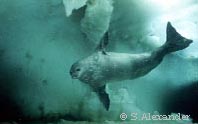
Under the sea ice:
The Weddell Seal, Leptonycotes weddelli, is a remarkable diver. It can dive to depths of 600 meters for periods up to an hour, though the usual dives are 20 minutes. The seal may make ten or twenty of these dives in a day.
|
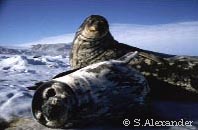
Basking Weddell Seals:
When Weddell Seals are not swimming in the water or foraging for food, the spend their time basking under the Antarctic Sun, but this is usual done laying on the sea ice.
|
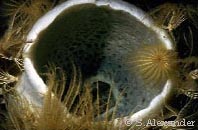
Antarctic Barrel Sponge:
The Barrel Sponge, Rosella racovitzae, is a large sponge, some specimens are over six feet tall, some are estimated to be hundreds of years old. Like all sponges, they feed by slowly circulating seawater through their bodies and removing tiny food particles. Here, some crinoids are sitting on a sponge to get a better place for themselves to feed.
|
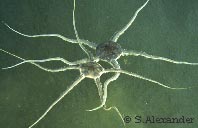
Brittlestars:
Two brittlestars, Ophionotus victoriae, sitting on an icy surface. Usually, brittlestars crawl around over the sediment bottom feeding on organic debris.
|
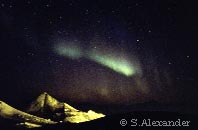
Aurora australis:
Phosphorescent curtains of light that are seen only during the Antarctic night. Incoming showers of cosmic rays produce these extraordinary displays.
|

